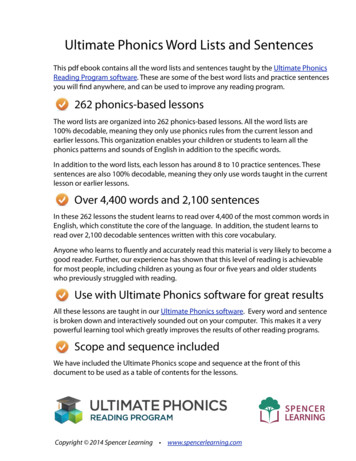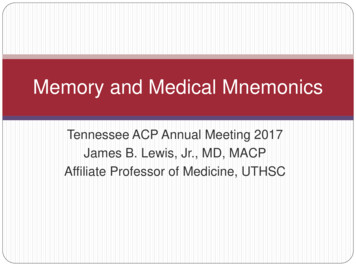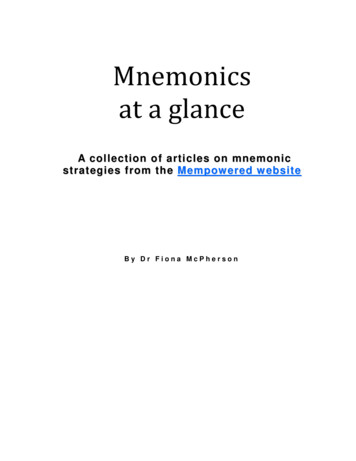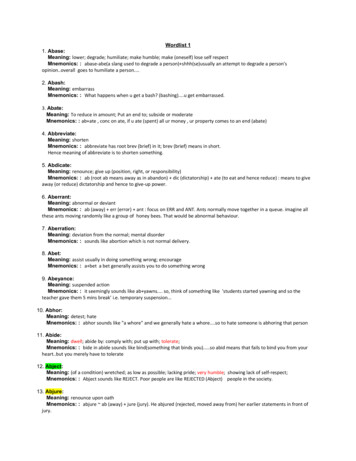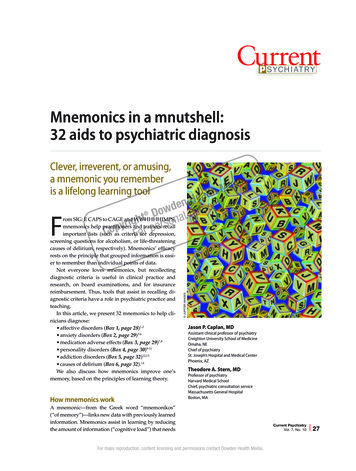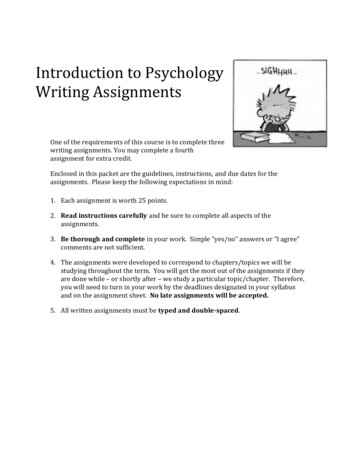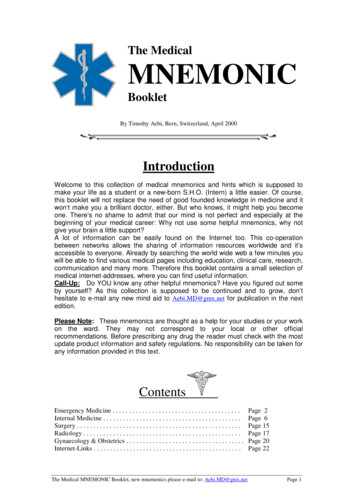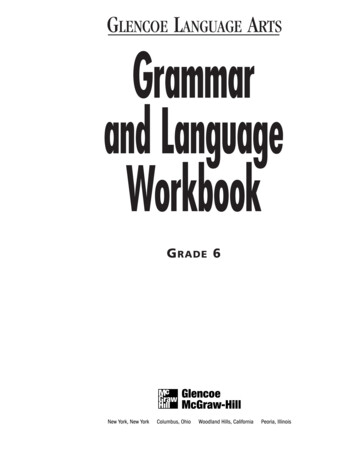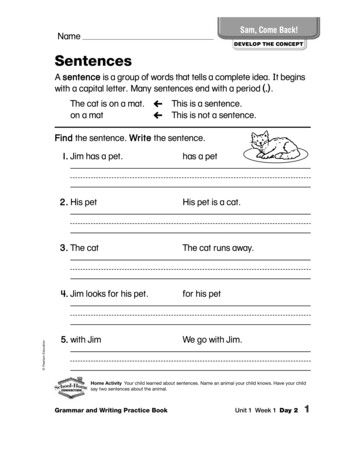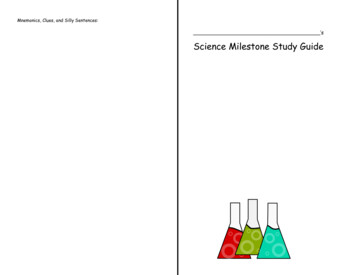
Transcription
Mnemonics, Clues, and Silly Sentences:’sScience Milestone Study Guide
Concepts and Facts:WordDefinition
STANDARD S8P1: Students will investigate the scientific view of theC. Describe the movement of particles in solid, liquid, gas and plasmanature of matter.states.Solve each riddle below to decide which state of matter it is describing:A. Distinguish between atoms and molecules.Label each picture as an atom or a molecule:1.My particles spread wide and far, they will fill any space from room tojar. I am a .2. My particles hold a specific shape, held in real tight and can’t escape.I am a .3. I slip and slide and have a flow, into many shapes I can go. I am a.4. Super charged and I have a zing, I make up the stars and evenAn atom is .A molecule is .B. Describe the difference between pure substances and mixtures.Label each picture as a PS or a M:1.What is a pure substance?lightning. I am a .D. Distinguish between physical and chemical properties of matter asphysical or chemical.Label each property as P (physical) or C (chemical)boiling Pointmelting Pointdensitycombustibilityreactivityability to ityE. Distinguish between changes in matter as physical or chemical.Identify each picture as a P (physical) change or a C (chemical) change.2. What is a mixture?3. How can you tell the difference between a PS and a M?
F. Recognize that there are more than 100 elements and some havesimilar properties as shown on the Periodic Table of Elements.Always remember:Atomic Number is the smaller of the two numbers. It tells you how manyprotons an atom has, and also tells you how many electrons in a neutralType of Element MetalsNonmetalsMetalloidsatom. Atomic Mass is MASSIVE and it tells you the number of protonsPLUS the number of neutrons. To get the number of neutrons subtract theatomic number from the atomic mass (big # - small #)PropertiesG. Identify and demonstrate the Law of Conservation of Matter.The Law of Conservation of Matter States: Matter can not beor .Examples:Use the information from the periodic table square to fill in the chartbelow:NameSymbol AtomicNumberMnAtomicNumber of Number of Number ofMassProtonsNeutronsElectrons25IronRemember that the amount of matter on the LEFT of an equation mustequal the amount of matter on the RIGHT of an equation.1.3027Copper30FeSFeS56 g32 gg
STANDARD S8P2: Students will be familiar with the forms andKinetic Energy:transformations of energyA. Explain energy transformation in terms of the Law of Conservationof Energy.What is the Law of Conservation of Energy?Label each picture with the transformation(s) of energy that take place.B. Explain the relationship between potential and kinetic energy.Potential energy is:Explain how potential and/or kinetic energy are working in each of thepictures below:
C. Compare and contrast the different forms of energy and theirSTANDARD S8P3: Students will investigate the relationship betweencharacteristics.force, mass, and the motion of objects.Type of EnergyHeatLightCharacteristicsExamplesA. Determine the relationship between velocity and acceleration.Velocity:Acceleration:Use the graph to answer the question:ElectricityA. Velocity is increasing, sothecar is accelerating.B. Velocity is decreasing, so the car isaccelerating.MechanicalMotionC. Velocity is increasing, so the car isnot accelerating.D. Velocity is decreasing, so the caris not accelerating.potentialIdentify each unit as a unit of Acceleration (A), Velocity (V),Distance (D) or Time (T)Sound18 m/s8 mi42 s16 m/s/s2 m122 min50 cm/min20 s8 m/s/s
C. Demonstrate the effect of simple machines on work.B. Demonstrate the effort of balanced and unbalanced forces on anobject in terms of gravity, inertia and friction.Simple machines make work but not .Explain which simple machine(s) you can use in each situation and howGravity:it will help make work easier:1. Putting a motorcycle into the back of a trailer.Inertia:2. Lifting a flag to the top of the flagpole.Friction:3. Moving dirt from the front yard to the backyard.Calculate the net force in each scenario below:Direction of motion:4. Attaching two boards together.5. Splitting a log in half.6. Cutting paper.7. Lifting a car to change the tire.8. Moving from the bottom floor of the house to the top floor.9. Opening a can of peaches.Place a star inside the boxes that are UNBALANCED10. Cutting a piece of cheese.
STANDARD S8P4: Students will explore the wave nature of sound andC. Explain how the human eye sees objects and colors in terms ofelectromagnetic radiation.wavelengths.Explain why a sheet of white paper appears white:A. Identify the characteristics of electromagnetic and mechanicalwaves.Explain why a green leaf on a plant appears green:Characteristics of Electromagnetic Waves:An apple appears red because:Characteristics of Mechanical Waves:We see objects because:Explain why we can’t see objects or colors in the dark:B. Describe how the behavior of light waves is manipulated causingreflection, refraction, diffraction, and absorption.Label each scenario as reflection, refraction, diffraction orabsorption.1. Your black shirt heats up when you are outsidein the sun.2. You see your face looking back at you in a puddle3. Your legs look broken when you sit with themdangling in the pool water.4. Light comes through the slightly open windowshades.5. The bouncing back of light rays causes this.6. Light energy is transferred to a chloroplast.7. Light goes around an obstacle.8. Light bends when it goes from air to liquidD. Describe how the behavior of waves is affected by a medium (suchas air, water, solids). Fill in the blanks below to make the paragraphtrue.Sound waves travel fastest in a because theparticles are closer together. Sound waves can also travel throughand .
E. Relate the properties of sound to everyday experiences.Increasing amplitude increases the of the sound.1. Explain why you can hear an echo in an empty room?Decreasing amplitude decreases the of the sound.Decreasing frequency decreases the of the sound.2. What can you do to reduce echoes in a theater or recording studio?Increasing frequency increases the of the sound.3. Why does a siren change pitch when a police car passes you?Match the wave to the description:4. This phenomenon is called the effect.ACB5. Draw a diagram of the effect below:1. Which wave would produce the softest sound?DF. Diagram the parts of a wave and explain how the parts are2. Which wave would produce the loudestsound?3. Which sound would produce the sound withthe highest pitch?affected by changes in amplitude and pitch.Label the parts of the transverse wave:4. Which sound would produce the sound withthe lowest pitch?Waves only transfer .The electromagnetic spectrum is made of:An acronym to help me remember this from longest to shortestwavelength:Label the parts of the longitudinal wave:Uses for electromagnetic waves:
S8P5: Students will recognize characteristics of gravity, electricity,C. Investigate and explain that electric currents and magnets canand magnetism as major kinds of forces acting on nature.exert force on each other.A. Recognize that every object exerts gravitational force on every1. How can you use the materials below to make a magnet?other object and that the force exerted depends on how muchmass the objects have and how far apart they are.On Earth you have a mass of 140 kg. In space you will have a mass ofkg. Your mass is .Your weight changes depending on the force of . Themoon has 1/6 the gravity of Earth. If you weigh 120 lbs on Earth, whatwould you weigh on the moon?B. Demonstrate the advantages and disadvantages of a series andparallel circuit and how they transfer energy.Label the circuits as series or parallel and answer the questions:1.2. How can you make the electromagnet stronger?2.3. Draw magnets attracting and magnets repelling and label the poles:Type of circuit:Advantages/Uses:Disadvantages:4.How is magnetism used to create electricity?
STANDARD S8P1: Students will investigate the scientific view of theC. Describe the movement of particles in solid, liquid, gas and plasmanature of matter.states.A. Distinguish between atoms and molecules.Solve each riddle below to decide which state of matter it is describing:Label each picture as an atom or a molecule:1.My particles spread wide and far, they will fill any space from room tojar. I am a GAS2. My particles hold a specific shape, held in real tight and can’t escape.I am a SOLIDAtomMoleculeAtomMoleculeAnat-om is the smallest unit of a chemical compound that retains the properties of that chemical/element.A molecule is the smallest unit of a compound (two or more atoms of asubstance)B. Describe the difference between pure substances and mixtures.Label each picture as a PS or a M:3. I slip and slide and have a flow, into many shapes I can go. I am aLIQUID4. Super charged and I have a zing, I make up the stars and evenlightning. I am a PLASMAD. Distinguish between physical and chemical properties of matter asphysical or chemical.Label each property as P (physical) or C (chemical)Pboiling PointPmelting PointPdensityCcombustibilityCreactivityCability to compressibilityWhat is a pure substance? A substance made of only ONE kind ofE. Distinguish between changes in matter as physical or chemical.particle. Elements and compounds are pure substances.Identify each picture as a P (physical) change or a C (chemical) change.2. What is a mixture? Two or more substances PHYSICALLY combined3. How can you tell the difference between a PS and a M? A mixture canpCbe physically separated. A pure substance can not. A mixture hastwo or more kinds of particles. Only elements and compounds arepure substances.pCCp
F. Recognize that there are more than 100 elements and some havesimilar properties as shown on the Periodic Table of Elements.Always remember:Atomic Number is the smaller of the two numbers. It tells you how manyprotons an atom has, and also tells you how many electrons in a neutralType of Element MetalsNonmetalsatom. Atomic Mass is MASSIVE and it tells you the number of protonsMetalloidsPLUS the number of neutrons. To get the number of neutrons subtract theatomic number from the atomic mass (big # - small #)PropertiesShiny, malleable,Do not conduct heat orhard, good conelectricity very well,ductors of electric- brittle, little to no lusterity and heatExamples:Gold, silver, iron,platinum, sodium(Na)Hydrogen, helium, oxygen, carbon, nitrogen,phosphorusHave properties ofboth metals andnonmetals, brittle,fair conductors,metallic appearanceG. Identify and demonstrate the Law of Conservation of Matter.The Law of Conservation of Matter States: Matter can not be created ordestroyed.Boron, silicon, germanium, arsenic,antimony, tNameSymbol AtomicsubscriptsAtomicNumber of Number of Number ofNumberMassProtonsNeutronsElectronsRemember that the amount of matter on the LEFT of an equation mustequal the amount of matter on the RIGHT of an FeSFeS56 g32 g88 g
STANDARD S8P2: Students will be familiar with the forms andtransformations of energyKinetic Energy:The energy of motionA. Explain energy transformation in terms of the Law of Conservationof Energy.Explain how potential and/or kinetic energy are working in each of theWhat is the Law of Conservation of Energy?pictures below:Energy can not be created or destroyed, it can change form/be transformed.Label each picture with the transformation(s) of energy that take place.Mechanical kinetic energy brings the rollercoasterup to the top of the hill, it turns into potential energy (GPE) and is converted back to kinetic energy asthe coaster goes back down the hillPotential energy (GPE) at the top of the hill, kineticenergy as the person falls off of the hill.Mechanicalto electricalElectrical tothermalElectrical tothermal andelectromagnetic(light)Electrical tomechanicalAs the batter waits for the pitch there is potentialenergy, it is converted into kinetic energy. Also thechemical energy of food is converted into thermalenergy inside the body.As the bow is drawn elastic potential energy isstored. As the arrow is released the EPE is converted into kinetic energy.Electrical tothermal andEMElectrical tosound andEMElectrical tosoundB. Explain the relationship between potential and kinetic energy.Potential energy is: STORED ENERGY, The energy of positionThe chemical energy in the gasoline is convertedinto thermal, light and kinetic energy.
C. Compare and contrast the different forms of energy and theirSTANDARD S8P3: Students will investigate the relationship betweencharacteristics.force, mass, and the motion of objects.Type of EnergyCharacteristicsHeatFlows from a hotter area to acolder area. CAN travel as infrared waves through emptyspace. CAN travel through amedium.ExamplesA. Determine the relationship between velocity and acceleration.Velocity: The speed of an object in a given direction. MUST includethe direction! Units are measured in distance/time Direction. Example: meters/second West.Acceleration: The rate at which velocity changes over time. ALSO: achange in direction! If you turn but do not change your speed, youare still accelerating. Acceleration can be speeding up OR slowingLightElectricityTravels as electromagneticwaves. CAN travel throughempty space (via radiation).CAN travel through a mediumas well.downUse the graph to answer the question:A. Velocity is increasing, so the caris accelerating.Flow of electrons from negative to positive. Travels throughmaterials that are electricalconductors (metals)B. Velocity is decreasing, so the car isaccelerating.C. Velocity is increasing, so the car isMechanicalMotionThe sum of potential andkinetic energy. When a windmill is turning is an example.potentialThe energy of position, storedenergy. Can be elastic potential or gravitational potential.SoundAssociated with a vibration ordisturbance in a medium.MUST have a medium, travelsas longitudinal waves. Is amechanical wave.not accelerating.D. Velocity is decreasing, so the caris not accelerating.Identify each unit as a unit of Acceleration (A), Velocity (V),Distance (D) or Time (T)V 18 m/s WD 8 miT 42 sA 16 m/s/sD 2 mT 122 minV 50 cm/min NT 20 sA 8 m/s/s
STANDARD S8P4: Students will explore the wave nature of sound andC. Explain how the human eye sees objects and colors in terms ofelectromagnetic radiation.wavelengths.Explain why a sheet of white paper appears white: All wavelengths of lightA. Identify the characteristics of electromagnetic and mechanicalwaves.in the visible light spectrum are reflected back to your eye.Explain why a green leaf on a plant appears green: Wavelengths of greenCharacteristics of Electromagnetic Waves:light are reflected back to your eye.Can travel through a medium or through empty space (via radiation). Con-An apple appears red because: Wavelengths of red light are reflectedsists of alternating electric and magnetic fields. Drawn as transverseback to your eye.waves. Higher frequency-more energy.Characteristics of Mechanical Waves: NEED a medium to travel, can notWe see objects because: Light reflects off of the objects and is inter-travel through empty space. Include sound waves, waves in a slinky, andpreted by our brains.earthquake wavesB. Describe how the behavior of light waves is manipulated causingreflection, refraction, diffraction, and absorption.Explain why we can’t see objects or colors in the dark: There is no light toreflect off of objects back to our eyes.Label each scenario as reflection, refraction, diffraction orabsorption.absorption 1. Your black shirt heats up when you are outside in thesun.reflection2.You see your face looking back at you in apuddlerefractionD. Describe how the behavior of waves is affected by a medium (suchas air, water, solids). Fill in the blanks below to make the paragraphtrue.Sound waves travel fastest in a SOLID because the particles are closertogether. Sound waves can also travel through LIQUID and GASES.3. Your legs look broken when you sit with them danglingin the pool water.diffraction4. Light comes through the slightly open window shades.reflection5. The bouncing back of light rays causes this.absorption6. Light energy is transferred to a chloroplast.diffraction7. Light goes around an obstacle.refraction8. Light bends when it goes from air to liquidSometimes sound and light diffracts, reflects, or refracts when it encounters different obstacles.
E. Relate the properties of sound to everyday experiences.Increasing amplitude increases the LOUDNESS of the sound.1. Explain why you can hear an echo in an empty room? The sound reflectsDecreasing amplitude decreases the LOUDNESS of the sound.off of the smooth walls and there is nothing to absorb sound.2. What can you do to reduce echoes in a theater or recording studio?Decreasing frequency decreases the PITCH of the sound.Increasing frequency increases the PITCH of the sound.Add soft panels or soft furniture to absorb sound.3. Why does siren change pitch when a police car passes you?Match the wave to the description:The change in wavelength as the siren moves towards you.A4. This phenomenon is called the Doppler effect.CB5. Draw a diagram of the Doppler effect below:C. 1. Which wave would produce the softest sound?DA. 3. Which sound would produce the sound with thehighest pitch?F. Diagram the parts of a wave and explain how the parts areaffected by changes in amplitude and pitch.B. 4. Which sound would produce the sound with thelowest pitch?Label the parts of thetransverse wave:1.D. 2. Which wave would produce the loudest sound?amplitude2. CrestWaves only transfer ENERGY.3. Wave heightThe electromagnetic spectrum is made of:4. WavelengthRADIO, MICROWAVE, INFRARED, VISIBLE LIGHT, ULTRAVIOLET,5. troughX-RAY, GAMMA RAYAn acronym to help me remember this from longest to shortestLabel the parts of the longitudinal wave:wavelength:1.compression2. Rarefaction3. wavelengthUses for electromagnetic waves:Transmit information (radio, micro) heat food (micro, infrared) treatcancer ( gamma) take pictures of bones (x-ray) see (visible light)
C. Demonstrate the effect of simple machines on work.B. Demonstrate the effort of balanced and unbalanced forces on anobject in terms of gravity, inertia and friction.Simple machines make work EASIRE but not LESS Explain which simple machine(s) you can use in each situation and howGravity: The force of attraction between two objects, depends on massand distanceit will help make work easier:1. Putting a motorcycle into the back of a trailer. Inclined plane as aInertia: An object in motion will remain in motion, an object at rest willremain at rest UNLESS acted upon by an unbalanced force.ramp to roll the motorcycle up rather than lifting it.2. Lifting a flag to the top of the flagpole. Pulley to pull the flag up.Friction: The resistance to motion of one object moving against anotherobject. Increased roughness increased friction.3. Moving dirt from the front yard to the backyard. WheelbarrowCalculate the net force in each scenario below:uses inclined planeDirection of motion:40 N60 NLeft (or West)Right (or East)Right (or East)2NNo Motion0NNo Motion4. Attaching two boards together. Screw5. Splitting a log in half. Wedge (axe blade)6. Cutting paper. Scissors (Lever and wedge)7. Lifting a car to change the tire. Jack (Lever)8. Moving from the bottom floor of the house to the top floor. Stairs(inclined plane)0N9. Opening a can of peaches. Can opener (lever, wedge and screw)Place a star insidethe boxes that are UNBALANCED10. Cutting a piece of cheese. Knife (wedge)
S8P5: Students will recognize characteristics of gravity, electricity,C. Investigate and explain that electric currents and magnets canand magnetism as major kinds of forces acting on nature.exert force on each other.A. Recognize that every object exerts gravitational force on every1. How can you use the materials below to make a magnet?other object and that the force exerted depends on how muchmass the objects have and how far apart they are.On Earth you have a mass of 140 kg. In space you will have a mass of 140kg. Your mass is constant.Your weight changes depending on the force of gravity. The moon has 1/6the gravity of Earth. If you weigh 120 lbs on Earth, what would you weighon the moon? 20 lbsB. Demonstrate the advantages and disadvantages of a series andparallel circuit and how they transfer energy.Label the circuits as series or parallel and answer the questions:1.2. How can you make the electromagnet stronger?Increase the number of wraps of the wire or increase the current (more orstronger batteries)2.3. Draw magnets attracting and magnets repelling and label the poles:Type of circuit:Series CircuitParallel CircuitAdvantages/Uses:Burglar alarmDisadvantages:If one light goes out,They all go out, lights get dimmeras you add loadsWiring in homes. All other lights stay on ifthere is a break in the circuit (branches)4.How is magnetism used to create electricity?Moving magnet through a coil of wire (stator) can generateelectricity.
5. Draw a diagram of the _ effect below: F. Diagram the parts of a wave and explain how the parts are affected by changes in amplitude and pitch. Label the parts of the transverse wave: Label the parts of the longitudinal wave: Increasing amplitude increases the _ of the sound.
